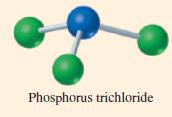Question: (A) In Practice Example 4-11A, which reactant is in excess and what mass of that reactant remains after the reaction to produce PCl 3 ?
(A) In Practice Example 4-11A, which reactant is in excess and what mass of that reactant remains after the reaction to produce PCl3?
(B) If 12.2 g H2 and 154 g O2 are allowed to react, which gas and what mass of that gas remains after the reaction?
2 H2(g) + O2(g) → 2 H2O(l)
Practice Ex. 4-11(A)
If 215 g P4 is allowed to react with 725 g Cl2 in the reaction in Example 4-11, how many grams of PCl3 are formed?
Example 4-11
Phosphorus trichloride, PCl3 is a commercially important compound used in the manufacture of pesticides, gasoline additives, and a number of other products. A ball-and-stick model of PCl3 is shown below. Liquid PCl3 is made by the direct combination of phosphorus and chlorine.
![]()
What is the maximum mass of PCl3 that can be obtained from 125 g P4 and 323 g Cl2?

Cl2(g) 4 PC13(1) P4(s) + 6 Cl2(g)
Step by Step Solution
3.31 Rating (154 Votes )
There are 3 Steps involved in it
A To determine which reactant is in excess we need to calculate the limiting reactant We can do this ... View full answer

Get step-by-step solutions from verified subject matter experts


